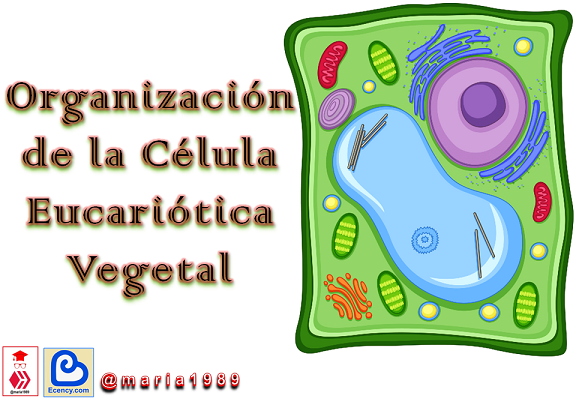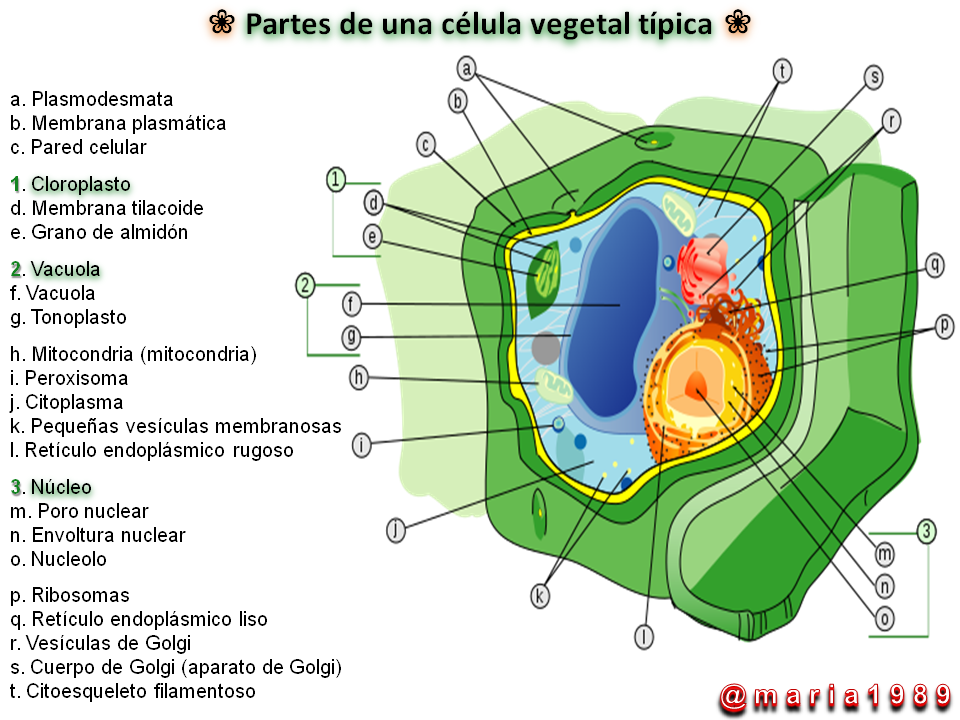Organización de la Célula Eucariótica Vegetal [ES❀EN]

Con el afanoso deber de contribuir en el fortalecimiento del proceso educativo de todos los lectores de este ecosistema, me permito exponer mis conclusiones acerca de la investigación de la Célula Eucariótica Vegetal. Desde su definición dentro el área de las Ciencias Naturales, las regiones o componentes que la integran, además de sus diferencias con la célula animal.

“…es el tipo de célula eucariota de la que están compuestos por muchos tejidos vegetales. A menudo, es descrita con los rasgos de una célula del parénquima de una planta vascular. Pero sus características no pueden generalizarse con el resto de las células meristemáticas o adultas de una planta y menos aún a las de los muy diversos organismos imprecisamente llamados vegetales…” ❀ Célula Vegetal
La célula vegetal difiere en muchos aspectos de la animal. Sí bien presenta las mismas regiones (citoplasma y núcleo rodeado de membrana) y la mayor parte de los orgánulos de la célula animal (mitocondrias, aparato de Golgi, retículo endoplásmico y ribosomas), carece de centriolos y posee unos orgánulos que no aparecen en aquella, los Plastos. El sistema vacuolar está muy desarrollado y las Vacuolas suelen ocupar la mayor parte del volumen celular; contienen diversos productos de reserva, como almidones.
Uno de los tipos de plastos que se pueden observar en las células vegetales, los cloroplastos, son los encargados de realizar la fotosíntesis. Estos orgánulos, que, al igual que las mitocondrias, poseen su propio ADN, tienen doble membrana y en su interior presentan una serie de sáculos aplanados o tilacoides dispuestos en pilas, la grana, donde se realiza la fase luminosa de la fotosíntesis, y un conjunto de laminillas o lamelas que unen entre sí los grana. El resto del contenido del cloroplasto constituye el estroma y en él se verifica la fase oscura de la fotosíntesis.
Aunque la existencia de la célula se conocía ya desde 1665, año en el que Robert Hooke, observó por primera vez la presencia de innumerables “celdillas” en la estructura a primera vista homogénea de un tapón de corcho, no fue sino hasta el siglo XIX cuando se estableció el papel fundamental de la misma en el funcionamiento de los organismos, como unidad básica de éstos.
Cualquier célula eucariótica, animal o vegetal, comprende dos partes bien diferenciadas en cuanto a composición y función: el núcleo y el citoplasma. Sin embargo, dada la diferente fisiología de ambos tipos celulares, no todos los orgánulos citoplasmáticos son comunes.
Todas las células están separadas del medio circundante por una doble capa de lípidos y proteínas, la membrana plasmática, pero las células vegetales protegen además su membrana con una estructura más o menos rígida, la pared celular, fundamentalmente celulósica, que les confiere consistencia.
El citoplasma celular, de composición heterogénea, contiene, además de un alto porcentaje de agua, lípidos, carbohidratos, una gran parte de enzimas que intervienen en el metabolismo celular, productos intermediarios de éste y una serie de proteínas organizadas en una red o retículo submicroscópico entre el que se desplaza el componente acuoso mediante movimientos de traslación, irregulares y de dirección variable en respuesta a los estados fisicoquímicos de la célula. Estos movimientos pulsátiles, los denominados movimientos brownianos, son debidos a las colisiones que se producen entre los solutos citoplasmáticos.
En la red proteica están organizados los distintos orgánulos citoplasmáticos, entre los cuales cabe destacar, como comunes entre células animales y vegetales:
Retículo endoplásmico, formado por una serie de túbulos interconectados y aplanados de membrana simple. Estos túbulos o cisternas pueden estar cubiertos de pequeñas partículas carentes de membrana, los ribosomas, encargados de la síntesis de proteínas, denominándose entonces retículo endoplásmico rugoso. En caso contrario, se habla de retículo endoplásmico liso. Ambos están conectados entre sí (a veces también con la membrana nuclear) y constituyen un sistema de transporte intracelular.
La síntesis de polisacáridos complejos, entre ellos la celulosa, se realiza en el aparato de Golgi, conjunto de sacos apilados que constituyen un dictiosoma, rodeado de pequeñas vesículas de secreción.
El metabolismo energético tiene lugar en las mitocondrias, orgánulos rodeados por una doble membrana, donde se encuentran todas las enzimas respiratorias de la célula, así como las proteínas transportadoras de electrones, englobadas dentro de las crestas mitocondriales o invaginaciones de la membrana interna.
El núcleo, región fundamental de la célula, es el lugar donde se encuentra toda la información genética que dirige el desarrollo y la reproducción celular. En una célula interfásica se aprecia una doble membrana, la envoltura nuclear, que separa el contenido nuclear, nucleoplasma, del citoplasma circundante. En el interior de dicha envoltura se halla la cromatina, material denso compuesto de ADN y ciertas proteínas básicas asociadas al mismo, las histonas, sustancia que se condensa y se espiraliza cuando la célula inicia la mitosis, originando estructuras en forma de bastón, los cromosomas, visibles al microscopio óptico y divididos en dos brazos desiguales por el centrómero. Algunos cromosomas presentan una constricción secundaria que separa el ADN satélite u organizador nucleolar, así llamado debido a que sintetiza el ARN ribosómico constituyente del nucléolo. Este último, es una estructura nuclear sin membrana y más refringente que la cromatina al microscopio óptico.
El número de cromosomas es siempre constante para todas las células vegetales de un mismo individuo y de una misma especie. Por lo general puede haber dos copias del mismo cromosoma (número diploide), aunque a veces puede existir dos o tres, fenómeno denominado poliploidía.
Los componentes celulares típicamente vegetales son: Plasto, Vacuola y Pared Celular; los cuales serán reseñados con gran detalle en el siguiente artículo.
¡ SIEMPRE GRACIAS
POR SU AMABLE ATENCIÓN !
POR SU AMABLE ATENCIÓN !

Dedico este informe a la formación educativa y cultural de todo aquel que conoce su importancia y respeta lo valioso de la educación integral
❀ Todo este material es producto de una investigación universitaria para la cátedra de Biología (L.U.Z.), va dirigido al nivel escolar de primaria y también secundaria, para el agrado y satisfacción de quienes estén solicitando dicha información.
❀ @maria1989 ❀


With the eager duty to contribute to the strengthening of the educational process of all the readers of this ecosystem, I would like to present my conclusions about the investigation of the Eukaryotic Plant Cell. From its definition within the area of Natural Sciences, the regions or components that make it up, as well as its differences with the animal cell.

“…is the type of eukaryotic cell of which many plant tissues are composed. It is often described with the features of a vascular plant parenchyma cell. But its characteristics cannot be generalised to the rest of the meristematic or adult cells of a plant and even less to those of the very diverse organisms imprecisely called plants...”
The plant cell differs in many ways from the animal cell. Although it has the same regions (cytoplasm and membrane-surrounded nucleus) and most of the organelles of the animal cell (mitochondria, Golgi apparatus, endoplasmic reticulum and ribosomes), it lacks centrioles and possesses organelles that do not appear in the animal cell, the Plastids. The vacuolar system is highly developed and the Vacuoles usually occupy most of the cell volume; they contain various reserve products, such as starches.
One of the types of plastids that can be observed in plant cells, chloroplasts, are responsible for photosynthesis. These organelles, which, like mitochondria, have their own DNA, have a double membrane and a series of flattened saccules or thylakoids arranged in stacks, the grana, where the light phase of photosynthesis takes place, and a set of lamellae that join the grana together. The remaining contents of the chloroplast constitute the stroma, where the dark phase of photosynthesis takes place.
Although the existence of the cell was known as early as 1665, the year in which Robert Hooke first observed the presence of innumerable "cells" in the at first sight homogeneous structure of a cork stopper, it was not until the 19th century that the fundamental role of the cell in the functioning of organisms was established as a basic unit of the organism.
Any eukaryotic cell, animal or plant, comprises two well-differentiated parts in terms of composition and function: the nucleus and the cytoplasm. However, given the different physiology of the two cell types, not all cytoplasmic organelles are common.
All cells are separated from the surrounding medium by a double layer of lipids and proteins, the plasma membrane, but plant cells also protect their membrane with a more or less rigid structure, the cell wall, mainly cellulose, which gives them consistency.
The cell cytoplasm, which is heterogeneous in composition, contains, in addition to a high percentage of water, lipids, carbohydrates, a large proportion of enzymes involved in cell metabolism, intermediary products of metabolism and a series of proteins organised in a submicroscopic network or reticulum through which the aqueous component moves by means of irregular, translational movements of variable direction in response to the physico-chemical states of the cell. These pulsatile movements, so-called Brownian movements, are due to collisions between cytoplasmic solutes and the aqueous component.
The different cytoplasmic organelles are organised in the protein network, among which the most important are those common to both animal and plant cells:
Endoplasmic reticulum, consisting of a series of interconnected, flattened, single-membraned tubules. These tubules or cisternae may be covered with small, membraneless particles, the ribosomes, which are responsible for protein synthesis, and are referred to as the Rough Endoplasmic Reticulum. Otherwise, it is called the Smooth Endoplasmic Reticulum. Both are connected to each other (sometimes also to the nuclear membrane) and constitute an intracellular transport system.
The synthesis of complex polysaccharides, including cellulose, takes place in the Golgi apparatus, a collection of stacked sacs that constitute a dictyosome, surrounded by small secretory vesicles.
Energy metabolism takes place in the mitochondria, organelles surrounded by a double membrane, where all the respiratory enzymes of the cell are located, as well as the electron transport proteins, enclosed within the mitochondrial ridges or invaginations of the inner membrane.
The nucleus, the fundamental region of the cell, is the location of all the genetic information that directs cell development and reproduction. In an interphase cell, a double membrane, the nuclear envelope, separates the nuclear contents, nucleoplasm, from the surrounding cytoplasm. Inside this envelope is the chromatin, a dense material composed of DNA and certain basic proteins associated with it, the histones, a substance that condenses and spirals when the cell begins mitosis, giving rise to rod-shaped structures, the chromosomes, visible under the light microscope and divided into two unequal arms by the centromere. Some chromosomes have a secondary constriction that separates the satellite DNA or nucleolar organiser, so called because it synthesises the ribosomal RNA that makes up the nucleolus. The latter is a nuclear structure without a membrane and more refringent than chromatin under the light microscope.
The number of chromosomes is always constant for all plant cells of the same individual and species. There can usually be two copies of the same chromosome (diploid number), although sometimes there can be two or three, a phenomenon known as polyploidy.
Typical plant cellular components are: Plastid, Vacuole and Cell Wall; which will be reviewed in great detail in the following article.
ALWAYS THANK YOU
FOR YOUR LOVING CARE !
FOR YOUR LOVING CARE !

I dedicate this report to the educational and cultural training of everyone who knows its importance and respects the value of integral education
❀ All this material is the product of a university research for the Biology (L.U.Z.), it is directed to the primary school level and high school, for the pleasure and satisfaction of those who are requesting this information.
❀ @maria1989 ❀

Artículos de consulta ❀ Reference articles:
❀ Estructuras de las células vegetales
(Plant cell structures)
❀ Célula vegetal: qué es, partes, características y funciones
(Plant cell: what it is, its parts, characteristics and functions)
❀ Célula Vegetal
(Plant Cell)
C R E D I T O S ❀ C R E D I T S:
❀ Las imágenes de dominio público fueron reeditadas con las aplicaciones: Paint y PowerPoint, formateadas como archivo PNG
❀ The images (public domain) were re-edited with the applications: Paint and PowerPoint, formatted as PNG file.

Brings me back to my science lessons days :)
!PIZZA
Me gusta siempre tu estilo de como presentas tus artículos; son bien explicados y acompañados de una imagen exacta.
Nice jump-back to my Junior High School where I studied these topics. Thanks!
Thanks for your contribution to the STEMsocial community. Feel free to join us on discord to get to know the rest of us!
Please consider delegating to the @stemsocial account (85% of the curation rewards are returned).
You may also include @stemsocial as a beneficiary of the rewards of this post to get a stronger support.
Congratulations your publication has been chosen among the best of the day.
KEEP CREATING GOOD CONTENT.
Congratulations @maria1989! You have completed the following achievement on the Hive blockchain And have been rewarded with New badge(s)
Your next target is to reach 10000 upvotes.
You can view your badges on your board and compare yourself to others in the Ranking
If you no longer want to receive notifications, reply to this comment with the word
STOPCheck out our last posts:
Support the HiveBuzz project. Vote for our proposal!